
Email Communication
Email remains a cornerstone of digital communication, offering insurance agents a versatile platform for interaction. Here are some key applications:
a. Policy Updates
Insurance agents can use email to send policy updates, coverage changes, and relevant information directly to clients. This ensures timely communication and keeps clients informed about any modifications to their policies.
b. Newsletters
Agents can create newsletters to share industry insights, tips for risk management, and updates on new insurance products. Regular newsletters help agents stay top-of-mind with clients and position themselves as knowledgeable professionals.
c. Renewal Reminders
Automated email reminders can be set up to notify clients about upcoming policy renewals. This ensures that clients have ample time to review their coverage and address any changes or concerns.
d. Educational Content
Utilize email to share educational content, such as blog posts, videos, or infographics, that help clients better understand insurance concepts, industry trends, and risk management strategies.
Social Media Engagement
Social media platforms have become powerful tools for building an online presence and engaging with clients. Insurance agents can leverage various social media channels for:
a. Brand Building
Establish and enhance your brand by maintaining active profiles on platforms like LinkedIn, Twitter, or Facebook. Share relevant content, participate in industry discussions, and showcase your expertise.
b. Client Interaction
Use social media as a platform for client interaction. Respond to inquiries, address concerns, and engage with clients on a more personal level. Direct messaging features on platforms like Facebook can facilitate private conversations.
c. Educational Campaigns
Create and share educational campaigns on social media to raise awareness about insurance topics, debunk common myths, and provide valuable information to your audience.
d. Announcements and Updates
Keep clients informed about company news, events, and updates through social media posts. This adds a dynamic element to your communication strategy and allows for real-time interaction.
Video Conferencing and Webinars
The rise of video conferencing tools has opened up new possibilities for insurance agents to connect with clients, colleagues, and prospects. Applications include:
a. Virtual Client Meetings
Conduct virtual client meetings to discuss policies, address concerns, and provide personalized consultations. Video conferencing adds a personal touch to interactions, especially in a digital era.
b. Educational Webinars
Host webinars on insurance-related topics to educate clients and prospects. Webinars allow agents to share in-depth information, answer questions in real-time, and position themselves as industry experts.
c. Training Sessions
Use video conferencing for internal training sessions within your agency. This ensures that your team is well-versed in the latest industry trends, products, and best practices.
d. Claim Assessments
Conduct virtual claim assessments, allowing clients to showcase damages through video. This can expedite the claims process and enhance the overall customer experience.
Text Messaging (SMS)
While not as extensive as email, text messaging can be a valuable tool for quick and direct communication. Insurance agents can use SMS for:
a. Appointment Reminders
Send automated appointment reminders to clients, reducing the likelihood of missed meetings and ensuring efficient use of time for both parties.
b. Urgent Updates
Use text messages for urgent updates, such as policy changes, time-sensitive announcements, or critical information that requires immediate attention.
c. Claim Status Updates
Keep clients informed about the status of their claims through brief and timely text messages. This provides transparency and reassures clients during potentially stressful situations.
d. Surveys and Feedback Requests
Gather client feedback through SMS-based surveys. This allows agents to assess satisfaction levels, identify areas for improvement, and enhance overall service quality.
Interactive Chatbots
Integrating chatbots into websites or communication platforms can enhance customer service and streamline interactions. Insurance agents can use chatbots for:
a. 24/7 Customer Support
Provide round-the-clock customer support through chatbots, answering frequently asked questions and assisting clients with basic queries at any time.
b. Policy Information
Implement chatbots to help clients access policy information, coverage details, and premium calculations. This self-service option enhances the client experience and reduces the workload on customer service teams.
c. Claims Reporting
Allow clients to initiate the claims reporting process through chatbots. This streamlined approach expedites the initial steps of a claim and improves overall efficiency.
d. Lead Qualification
Use chatbots to qualify leads on your website by gathering basic information and directing them to the appropriate agent or department for further assistance.
Insurance agents must embrace a diverse range of communication tools to stay connected with clients and remain competitive in the market. Each type of digital communication serves a unique purpose, from providing timely updates through emails to engaging with clients on social media platforms and conducting virtual meetings via video conferencing.
By strategically incorporating these digital communication methods into their workflows, insurance agents can enhance client relationships, streamline processes, and position themselves as tech-savvy professionals in an industry that continues to evolve. The key is to adapt to the preferences of clients and leverage technology to create a seamless and personalized communication experience that sets agents apart in the competitive landscape of the insurance industry.

